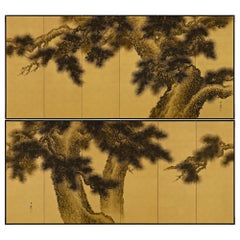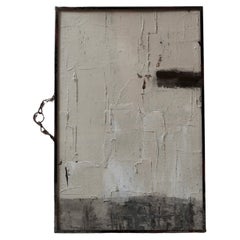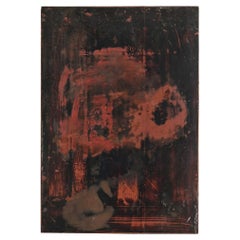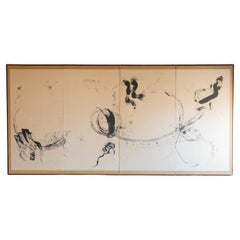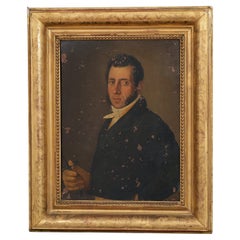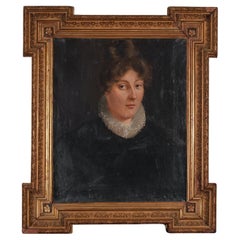Japan - Paintings
85
2
1
to
2
12,815
6,874
88
88
88
2
26
37
22
3
14
2
3
2
1
4
1
1
1
Height
to
Width
to
45
39
31
28
27
69
56
53
17
12
2
1
1
1
1
Item Ships From: Japan
Early 20th Century Japanese Screen Pair - Ink Pine Trees on Gold
Located in Kyoto, JP
Imao Keisho (1902-1993)
Pine Trees
Early 20th Century, Circa 1930
Pair of six-panel Japanese screens. Ink on silk and gold leaf.
Dimensions: Each screen H. 67.5” x 148” (172 cm x 376 cm)
A pair of monumental six-panel Japanese pine screens by the renowned Nihonga artist Imao Keisho. Here Keisho entirely removed the background and brought the pine trees to the surface of the painting. This simplification of the elements makes the scene exceptionally direct and compelling and injects a very modern...
Category
Early 20th Century Japanese Showa Japan - Paintings
Materials
Gold Leaf
Small Wall Hanging Art / Japanese paper / Sand paint / Ink
Located in Iwate-gun Shizukuishi-cho, Iwate Prefecture
This is a small wall hanging picture.
Japanese paper is pasted and colored on wooden panels.
In addition, sand-like paint is layered and partially colored with ink.
The boundary o...
Category
21st Century and Contemporary Japanese Japan - Paintings
Materials
Sandstone
A workbench used by a lacquer craftsman/Before 1972/Like an abstract painting
Located in Sammu-shi, Chiba
We have a unique Japanese aesthetic sense.
And only we can introduce unique items through our purchasing channels in Japan and the experience we have gained so far, in such a way tha...
Category
Late 20th Century Japanese Showa Japan - Paintings
Materials
Pine
Japanese Antique Folding Screen "雨路風 " 1974 /Mingei Wabisabi/
Located in Sammu-shi, Chiba
If you want something special, we recommend purchasing items selected by BROOD.
We sell carefully selected old Japanese items.
I've seen tens of thousands of items so far.
Based on t...
Category
1970s Japanese Showa Vintage Japan - Paintings
Materials
Paper
French Officer Portrait Oil-On-Copper c. 1830
Located in 263-0031, JP
A very rare oil-on-copper portrait of a French officer from Louis Philippe period of 1830-48. Paintings on copper sheeting are typically found only among the genre of small devotiona...
Category
Mid-19th Century Louis Philippe Antique Japan - Paintings
Materials
Copper
French Oil On Canvas Portrait of a Woman c. 1835
Located in 263-0031, JP
A French oil-on-canvas portrait of a woman from the Louis Philippe period of 1830-48. Her ensemble and hairstyle place her to the mid-1830s. The canvas is in good unlined condition (...
Category
Mid-19th Century French Antique Japan - Paintings
Materials
Canvas
French Oil On Canvas Portrait of a Man c. 1800
Located in 263-0031, JP
French oil on canvas portrait of a man c. 1800. The bourgeois gent depicted here displays the cliched hand-in-waistcoat mannerism of the 18th and early 19th century. He’s wearing wha...
Category
Early 19th Century French Antique Japan - Paintings
Materials
Canvas
17th Century Oil Painting School of Claude Lorrain
By (after) Claude Lorrain (Claude Gellée)
Located in 263-0031, JP
A copy of the 1636 painting “River Ford” by the French proto-plein-air painter Claude Lorrain (1600-1682). This suivier, or follower, has faithfully reproduced the original but revis...
Category
17th Century European Antique Japan - Paintings
Materials
Canvas
Early 18th-Century Baroque Portrait of a Nobleman
Located in 263-0031, JP
An oil-on-canvas full-scale portrait of a standing man in costume typical of the Baroque era of c. 1720, France. Purchased from a dealer in Geneva, Switzerland. The canvas is in good...
Category
Early 18th Century French Antique Japan - Paintings
Materials
Canvas
Young French Girl Portrait c. 1800 Oil On Canvas
Located in 263-0031, JP
Neoclassicism saturates this droll portrait of a French girl c. 1800: the high-waisted dress, the antique hairstyle "a la Titus” complemented with m...
Category
Early 18th Century French Neoclassical Antique Japan - Paintings
Materials
Canvas
Early 19th Century French Oil-On-Canvas Portrait of Boy
Located in 263-0031, JP
French oil-on-canvas portrait of boy. Dating from the Louis Philippe Era of 1830-45, this charming portrait is done in a naive manner that evokes American portraiture from the same p...
Category
1840s French Louis Philippe Antique Japan - Paintings
Materials
Canvas
Portrait of Gilles Armand Vaquier de la Baume c. 1825
Located in 263-0031, JP
Bourbon Restoration portrait of French man. Dating from c. 1825, this handsome oil on canvas painting depicts a *homme bourgeois* displaying all the earmarks of the of the less-milit...
Category
1820s French Antique Japan - Paintings
Materials
Canvas
Eighteenth-Century Portrait of an Italian Man
Located in 263-0031, JP
An oil-on-canvas portrait of an Italian nobleman from the period c. 1760. The subject poses in front of his extensive library. The canvas and frame are in excellent condition. The ma...
Category
Mid-18th Century European Antique Japan - Paintings
Materials
Canvas
Louis Philippe-Era Oil on Canvas Portrait of a Woman
Located in 263-0031, JP
Oil-on-canvas portrait of an elegant woman from the Louis Philippe Era (1830-48). The canvas and original frame are in excellent condition.
Category
Mid-19th Century French Louis Philippe Antique Japan - Paintings
Materials
Canvas
French Oil on Panel Painting of a Woman c. 1815
Located in 263-0031, JP
French oil on panel painting of a woman. Composed on a wooden panel, this c. 1815 oil depicts a woman displaying the exaggerated, theatrical mannerisms of the Neoclassical style that...
Category
Early 19th Century French Neoclassical Antique Japan - Paintings
Materials
Wood
Lepoittevin Early 19th Century Marine Oil Painting
By Eugene Le Poittevin
Located in 263-0031, JP
A marine tableau, oil on wood board, by the French Romantic painter Eugène Lepoittevin (1806-1870). The signature “Poitevin” appears in the lower right: our painter seems to have gon...
Category
Mid-19th Century French Antique Japan - Paintings
Materials
Canvas
Early 19th Century Oil Painting French Family Portrait
Located in 263-0031, JP
The term “Biedermeier” was first wielded as mildly disparaging designation for the bourgeois domesticity, so idealized by German society in the post-Napoleonic era prior to the 1848 ...
Category
Early 19th Century French Biedermeier Antique Japan - Paintings
Materials
Canvas
1822 Signed and Dated Oil On Canvas Portrait of a Man
Located in 263-0031, JP
A charming oil-on-canvas of a man from the reign of Louis XVIII (1815-24). On the reverse, the following inscription can be found: "Erra, Pinxit” (“Painted by Erra”) and date of Marc...
Category
1820s French Antique Japan - Paintings
Materials
Canvas
18th Century Oil Painting Portrait of Petrus Chevallier
Located in 263-0031, JP
A charming French 18th-century oil-on-canvas portrait of a pharmacist named Petrus Chevallier. Signed “Davila” verso, where it also dated “20 - 09 - 1753" and the title “Petrus Cheva...
Category
1750s French Antique Japan - Paintings
Materials
Canvas
18th Century Italian Nobleman Portrait Oil On Canvas
Located in 263-0031, JP
A handsome oil on canvas of an Italian nobleman c 1770. His droll expression is complemented by his galant powdered wig and three-cornered hat tucked under his left shoulder. The fra...
Category
Late 18th Century Italian Antique Japan - Paintings
Materials
Canvas
Japanese Screen Painting, Circa 1700 'Tales of Ise' by Tosa Mitsusuke
By Tosa Mitsusuke 1
Located in Kyoto, JP
A six-fold Japanese screen by Tosa Mitsusuke (1675-1710), Japan 17th-18th century, Edo period.
The signature reads Shoroku-i ge Tosa sa Konoe Shogen Mit...
Category
Late 17th Century Japanese Edo Antique Japan - Paintings
Materials
Gold Leaf
19th Century Japanese Screen Pair. Flowers & Birds of the Four Seasons
Located in Kyoto, JP
Flowers & Birds of the Four Seasons
Pair of six-fold Japanese Screens. Ink, color, gofun and gold on paper.
Second half of the 19th Centur...
Category
Late 19th Century Japanese Meiji Antique Japan - Paintings
Materials
Wood, Paper
Japanese Screen Painting, circa 1700 'Horses' by Kano Tanshin
Located in Kyoto, JP
Horses
Kano Tanshin Morimasa (1653-1718)
Two-panel tea-ceremony Japanese screen or furosaki
Ink on gold leaf,
late 17th-early 18th century
Measures: H 55 cm x W 182 cm
The Kano school was closely aligned with the warrior class in Japan. The samurai, who lived in a closed and rigid hierarchical society established by the Shogunate, were drawn to the energy and freedom horses symbolize; Kano school artists commonly depicted the equine creatures as they are here, in unfettered and carefree family groups. China originally introduced horse paintings to Japan; the works typically focused on capturing the essence of horses in their various environments and often involved integrating human figures into the images.
Kano Tanshin Morimasa (1653-1718) was the son of Kano Tanyu...
Category
1690s Japanese Edo Antique Japan - Paintings
Materials
Gold Leaf
Mid-18th Century Japanese Screen Pair, One Hundred Flowers, Chrysanthemums
Located in Kyoto, JP
Omori Soun (b. 1704)
Chrysanthemums - One Hundred Flowers
A Pair of Six-fold Japanese Screens. Ink, color, gofun and gold leaf on paper.
Dating ...
Category
Mid-18th Century Japanese Edo Antique Japan - Paintings
Materials
Gold Leaf
Japanese Painting, Hanging Scroll, 19th Century Bamboo in Moonlight
Located in Kyoto, JP
Bamboo in moonlight
Gamo Rakan (1784-1866)
Hanging scroll, ink on silk.
Dimensions:
Scroll: 201 cm x 58 cm
Image: 137 cm x 45 cm
In this early 19th century work by Gamo Rakan a light ink wash applied to the silk background silhouettes the moon and suggests the atmosphere of early evening. Even though it is a literati subject, Rakan’s bamboo is quite realistic with a strong decorative style. The painting finds its inspiration from Chinese Ming dynasty painters who often used a single-tone, jet black stroke to emphasize the calligraphic nature of bamboo.
In a different era, decorative would have been seen as somewhat unrefined. But increasingly in the Edo period, it was the hallmark of high style. The Japanese people, in particular the rising merchant class, had gradually become apathetic toward the traditional Sesshu and Kano schools of painting. Chinese professional and amateur painters living in the port of Nagasaki during the 18th century had a profound effect on Japanese painting and the freshness of their style and its decorative appeal contributed greatly to its popularity. Gamo Rakan’s teacher, Tani Buncho...
Category
Early 19th Century Japanese Edo Antique Japan - Paintings
Materials
Silk
Early 19th Century Japanese Screen. Cherry Blossom & Pheasants by Mori Tetsuzan
Located in Kyoto, JP
Mori Tetsuzan (1775-1841)
Pheasants and Cherry Blossoms
Two-fold Japanese screen. Ink, color, gofun, gold and silver on paper.
A two-fold Japanese bir...
Category
Early 19th Century Japanese Edo Antique Japan - Paintings
Materials
Gold Leaf
Japanese Kimono Art / Kimono Wall Art / Oil Painting, Lys Blanc
Located in Shibuya City, Tokyo
Kimono Wall Art by Kimono-Couture
Title:Lys Blanc
Prepare to be captivated by the extraordinary beauty of our exceptional oil painting, where a Japane...
Category
21st Century and Contemporary Japan - Paintings
Materials
Silk
Lake Side: Copy of Kuroda Seiko's Painting, Painting, Oil on Canvas
Located in Fukuoka, JP
Introducing a remarkable oil painting on linen canvas, meticulously reproduced to capture the essence of the renowned work by Kuroda Seiki. The original masterpiece, titled "Lake Sid...
Category
20th Century Japanese Japan - Paintings
Materials
Canvas, Linen, Wood
Hu Jie Ming Early Work
Located in Fukuoka, JP
The item is an early artwork of Chinese artist Hu Jieming.
Hu Jieming's groundbreaking artwork, recently sold at a Christie auction for 3500 pound sterlings, showcases his innovative approach to digital media and video installation...
Category
20th Century Chinese Japan - Paintings
Materials
Paper
"Awaiting" Painting by Leonid Steele, Famous Ukrainian Artist
Located in Fukuoka, JP
A stunning painting by Ukrainian artist Leonid Steele titled "Awaiting", created in 1972 during the Soviet era. The painting is in the human realist st...
Category
20th Century Ukrainian Japan - Paintings
Materials
Cotton
Meiji Period Japanese Screen Pair, One Hundred Birds by Hasegawa Gyokujun
Located in Kyoto, JP
One hundred birds
Hasegawa Gyokujun (1863-1921)
Meiji period, circa 1900.
Ink, color and gofun on silk.
Dimensions of each screen:
H. 170 cm x W. 190 cm (67’’ x 75”)
Despite the title, well over 100 birds are represented in this pair of two-fold Japanese screens (the title functions figuratively to convey the idea of a large number). The monumental work is rendered with a comprehensive and highly complex composition which is exquisitely executed and meticulously colored. More a celebration of naturalism than the traditional “One Hundred Birds” paintings which originated in China. This was a subject matter known for its auspicious meaning as much as its actual depiction of nature. These paintings generally had a phoenix (occasionally peacocks) placed in the center, and the other birds paying homage to it.
In this quintessentially Japanese scene painted by Gyokujun, a couple of long-tailed birds modeled after paradise flycatchers are included; these are traditional auspicious motifs in Oriental bird and flower painting and denote themes such as celebration and enduring generations. In addition there is the playful inclusion of single exotic parrot. Even so, the vast majority of the birds and flowers are native to Japan. Reading the scene from right to left, from spring through to autumn, the overwhelming sense is one of movement and haste. It is almost as if the birds are in a race, with the fleetest leading the way forward. Although these native birds were commonly drawn amongst artists of the Shijo school, rarely were they painted with such drama and dynamism. It is not strictly a depiction of sketched birds whose manner was faithfully handed down through the traditions of the Shijo school. Rather we see Gyokujun seeking and achieving new expressions in the heart of the turbulent Meiji period.
Hasegawa Gyokujun (1863-1921) was born in Kyoto. He was the eldest son of Hasegawa Gyokuho, a Shijo school painter who studied under Matsumura Keibun. Gyokujun studied painting under his father and became a prominent member of the Kyoto painti
ng world from a young age. In 1891 he established the ‘Young Painters Social Club’ along with Takeuchi Seiho, Miyake Gogyo and Taniguchi Kokyo. Also in 1891 he was selected as a judge of the Great Private Paintings Exhibition along with Takeuchi Seiho, Yamamoto Shunkyo...
Category
Early 1900s Japanese Meiji Antique Japan - Paintings
Materials
Silk, Wood
Early 20th Century Japanese Cherry Blossom Screen by Kano Sanrakuki
Located in Kyoto, JP
Cherry Blossoms
Kano Sanrakuki (1898-1981)
Showa period, circa 1930
2-panel Japanese Screen
Color, gofun and gold leaf on paper
Against a backdrop of gold-leafed ground, the lichen covered trunk and branches of the life-sized cherry blossom tree reach out and beyond the confines of the pictorial surface. The overall composition has a feeling of flatness which draws emphasis to the surface and the three-dimensionality of the cherry blossoms. Painstakingly built-up layers of thickly applied shell-white gofun detail the voluminous blossoms and cover large areas of this tour-de-force of Japanese Nihonga painting. By simplifying the background, minimizing the number of colors and depicting the blossoms with such heavy relief, the artist has emphasized the stunning presence of the cherry tree. The type of tree depicted is the Yae-Zakura; a double-layered type of cherry blossom famed for its beauty and strength. When we think of Japanese cherry blossoms, the first thing that comes to mind is Somei Yoshino variety, which has a single flower with five almost white petals. This type is fragile and easily blown away by strong wind or rain. Most of the double-flowered cherry blossoms begin to bloom when the Somei-Yoshino falls, and the flowering period lasts longer than that of the Somei-Yoshino.
Kano Sanrakuki originally studied painting at the Kyoto City Arts and Crafts School under the tutelage of Yamamoto Shunkyo...
Category
Early 20th Century Japanese Showa Japan - Paintings
Materials
Gold Leaf
17th Century Japanese Screen. Ink Plum Tree & Birds by Kano Naonobu.
Located in Kyoto, JP
Kano Naonobu (1607-1650)
Plum Tree and Birds
Six-fold Japanese Screen. Ink and slight color on paper.
In this evocative ink work spread over a six-panel folding screen, we see the consummation of the elegance and refinement of the Edo Kano school. This 17th century screen is a rare surviving example of a large-scale bird and flower painting by Kano Naonobu, the younger brother of Kano Tanyu...
Category
17th Century Japanese Edo Antique Japan - Paintings
Materials
Wood, Paper
19th Century Japanese Silk Painting by Kano Chikanobu, Phoenix & Paulownia
Located in Kyoto, JP
Birds & Flowers of the seasons
Pheasants & Plum in Snow
Unframed painting. Ink, pigment and gofun on silk
Kano Chikanobu 1819-1888
Signature...
Category
Mid-19th Century Asian Edo Antique Japan - Paintings
Materials
Silk
Antique hanging scroll of Japanese cat/Late Edo-Meiji period/Cat painting
Located in Sammu-shi, Chiba
This is a picture of a cat drawn by a person named "Toshizumi Nitta" from the end of the Edo period to the beginning of the Meiji period.
She is a very simple and cute cat.
He is a vassal of the Tokugawa Shogunate, born in Ota City, Gunma Prefecture (southern part of Gunma Prefecture).
He was related to the Tokugawa family and lived in a large mansion in the Ota clan in Gunma prefecture.
However, the Nitta family's territory was very small, and they were by no means a wealthy vassal.
He seems to have lived quite poorly.
So he painted cats and sold them to people.
The Nitta family continued to draw pictures of this cat for four generations.
"Nitta toshizumi" is equivalent to the fourth generation.
During the Edo period, sericulture was thriving in the Kanto region.
Cats were said to be the gods of silkworms, as they drive away mice, the natural enemies of silkworms.
It was the Nitta family who drew such a cat on paper, pasted it in the silkworm chamber, and sold it as a mouse repellent.
There were also other monks who painted pictures of cats, but the Nitta family in particular was related to the Tokugawa family, so people believed that paintings of cats had special powers. , a lot of paintings...
Category
Late 19th Century Japanese Edo Antique Japan - Paintings
Materials
Paper
19th Century Japanese Screen for Tea-Ceremony, Ink Bamboo and Plum on Gold Leaf
Located in Kyoto, JP
Three Friends of Winter
Nakajima Raisho (1796-1871)
Late Edo period, circa 1850
Ink and gold leaf on paper.
This is a double-sided Japanese Furosaki or tea-ceremony screen from the mid 19th century; bamboo and plum on the front, young pines the back. It by Nakajima Raisho, a master painter of the Maruyama school in the late Edo and early Meiji periods. In this work Raisho combines exquisite ink brushwork with large open spaces of brilliant gold-leaf to inspire the viewers imagination. Rather than naturalism, he is searching for the phycological impression of the motifs, resulting in abstraction and stylization. His simplification of the motifs the result of looking to capture the inner nature of the objects. This art motif is known as Sho Chiku Bai, or the Three Friends of Winter. Evergreen pine connotes steadfastness, bamboo suggests both strength and flexibility, while plum blossoms unfurling on snow-laden branches imply hardiness. Combined, this trio is emblematic of Japanese new year. Chinese literati were the first to group the three plants together due to their noble characteristics. Like these resilient plants flowering so beautifully in winter, it was expected of the scholar-gentleman to cultivate a strong character with which he would be able to show the same degree of perseverance and steadfastness even during times of adverse conditions.
The screen would have been placed near the hearth of a room used for the Japanese tea ceremony, shielding the fire from draughts and also forming a stimulating and decorative backdrop behind the tea utensils. It would have been used in the Hatsugama, or first tea-ceremony of the new year.
Nakajima Raisho (1796-1871) originally studied under Watanabe Nangaku before entering the school of Maruyama Ozui. He was the highest ranking Maruyama school painter at the end of the Edo period and was known as one of the ‘Four Heian Families’ along with Kishi...
Category
Mid-19th Century Japanese Edo Antique Japan - Paintings
Materials
Gold Leaf
17th Century Japanese Screen Pair. Tiger & Dragon by Kaiho Yusetsu
Located in Kyoto, JP
Kaiho Yusetsu (1598-1677)
Tiger and Dragon
Early Edo Period, Circa 1650
A Pair of Six-fold Japanese Screens. Ink and slight color on paper.
Dimensions:
Each screen: H. 171 cm x W. 380 cm (67.5’’ x 149.5’’)
In this pair of early Edo period Japanese screens a group of tigers prowl in a bamboo grove whipped with fierce wind, while a dragon claws through clouds and mist. The dragon embodies elemental qualities - looming out of the mist, the coils of its body disappearing in the clouds. The dragon is calling for rain, symbolizing spring which is considered the fountain of life. On the other side, the tigers calls for the wind, symbolizing autumn which is considered the end of life. Tigers were familiar motifs within Japanese art from ancient times though the animals were imaginary to the people in the 17th century. While dragons and tigers are usually associated as sacred and ferocious, in this painting, both animals have rather amusing expressions. The tigers appear to glare at the dragon with cat-like eyes, and the look on the swirling dragon’s face appears almost affectionate - lending a playful flair to an otherwise magnificent theme.
The tiger and dragon are cosmological symbols of the balancing forces in the world. Screens such as this were originally meant to express the fluctuating nature of the world. For Japanese in the early Edo period, they likely suggested the powers of the cosmos. In Japan the tiger and dragon motif was originally absorbed into the circles of Zen monasteries before spreading into the secular world. The theme especially appealed to the military classes with the Kano school, the official painters to the Shogun and the samurai, being the leading contributors. The painter of this pair of screens, Kaiho Yusetsu (1598-1677), was closely patronized by the third Shogun Tokugawa Iemitsu. In his later years he worked with Kano school artists...
Category
Mid-17th Century Japanese Edo Antique Japan - Paintings
Materials
Silk, Wood, Paper
Japanese Silver Screen Pair, Meiji Period, Herons & Plovers, Shijo School
Located in Kyoto, JP
Heron & Plovers
Ink and silver leaf on paper
Maekawa Bunrei (1837-1917)
A pair of low six-panel Japanese screens by Maekawa Bunrei, a later master of the Kyoto based Shijo school of painting. On the right screen a solitary white heron stands motionless in a stream. On the left screen plovers play along a shoreline. The elegant forms are executed employing fluid, minimalistic ink brushstrokes. The soft brushstrokes and the sharp light of the silver leaf lend the scenes a sense of translucence. The sophisticated composition superbly exploits the long, horizontal pictorial surface of the pair of folding screens...
Category
Early 1900s Japanese Meiji Antique Japan - Paintings
Materials
Silver Leaf
19th Century Japanese Silk Painting by Kano Chikanobu, Crane, Pine & Camelia
Located in Kyoto, JP
Birds & Flowers of the Seasons
Pheasants & Plum in Snow
Unframed painting. Ink, pigment and gofun on silk
Kano Chikanobu 1819-1888
Signature...
Category
Mid-19th Century Asian Edo Antique Japan - Paintings
Materials
Silk
circa 1930 Japanese Silver Screens by Isoi Joshin, Flowers of the Four Seasons
Located in Kyoto, JP
Flowers of the four seasons
Isoi Joshin (1883-1964)
Pair of six-panel Japanese screens
Ink, pigment, lacquer and silver leaf on pa...
Category
Mid-20th Century Asian Showa Japan - Paintings
Materials
Silver Leaf
17th Century Japanese Screen Pair, Cranes
Located in Kyoto, JP
Cranes
Anonymous, Kano School.
Edo period, second half of the 17th century.
Pair of six-panel screens. Ink, pigment gofun and gold l...
Category
1670s Japanese Edo Antique Japan - Paintings
Materials
Gold Leaf
19th Century Japanese Scroll Painting, Birds & Flowers of the Four Seasons
Located in Kyoto, JP
Birds and flowers of the four seasons
Early to mid-19th century
Ink, pigment and gofun on silk
Unidentified artist
Signature: S...
Category
1830s Japanese Edo Antique Japan - Paintings
Materials
Silk
19th Century Japanese Shunga Hand-Scroll, Katsukawa School
Located in Kyoto, JP
Shunga
Unknown artist
Meiji era, circa 1880
Hand-scroll mounted with 12 paintings
Ink, pigment and gofun on silk
Dimensions:
Each image measures H. 23.2 cm x W. 34.4 cm (9.15” x 13.5”)
The hand-scroll measures H. 28 cm x W. 540 cm (11” x 212”)
A set of 12 late 19th century Japanese Shunga paintings mounted as a hand-scroll. Two of the leaves bear the signature and seal ‘Setsuzan’, although we are unable to confirm the identity of the artist using this art name. 6 of the 12 images are taken almost directly from Katsukawa Shuncho’s late 18th century woodblock series, ‘Erotic Pictures...
Category
Late 19th Century Japanese Meiji Antique Japan - Paintings
Materials
Silk
19th Century Japanese Scroll Painting by Igarashi Chikusa, Poppies & Butterflies
Located in Kyoto, JP
Poppies & Butterflies
Ink, pigment and gofun on silk
Igarashi Chikusa (1774-1844)
Signature: Chikusa Ran Zen
Upper Seal: Ran Shuzen
Lower Seal: Kyoho
Dimensions:
Scroll: H. 68” x W. 18” (172cm x 45cm)
Image: H. 38.5’’ x W. 12.5’’ (98cm x 32cm)
This composition shows elegant images of poppies and the butterflies that are inevitably drawn to them. It captures a momentary glimpse into a world both visually dazzling and startlingly realistic. The painting is infused with sensitivity and attention to seasonal change and weather conditions. The thin and fragile poppies are beautifully depicted with brilliant colors and the butterflies are similarly infused with life. The painting is on silk which requires extremely precise painting skills as no element once painted can be removed.
Poppies were a favorite subject of Rinpa school artists through the ages. Originally they were somewhat abstracted but by the age of Sakai Hoitsu...
Category
Early 19th Century Japanese Edo Antique Japan - Paintings
Materials
Silk
Yoko Hiramaru, "Sweet Conversation", 2016
By Yoko Hiramaru
Located in Edogawa-ku Tokyo, JP
"Sweet Conversation" by Yoko Hiramaru, oil paint on linen.
Category
21st Century and Contemporary Japanese Japan - Paintings
Antique Work Board Used by Japanese Craftsmen/1868-1920/Wabi-Sabi Wall Painting
Located in Sammu-shi, Chiba
If you want something special, we recommend purchasing items selected by Brood.
We sell carefully selected old Japanese items.
I've seen tens of thousands of items so far.
Based o...
Category
Late 19th Century Japanese Meiji Antique Japan - Paintings
Materials
Cedar
19th Century Japanese Silk Painting by Kano Chikanobu, Pheasants & Plum in Snow
Located in Kyoto, JP
Birds & Flowers of the Seasons
Pheasants & Plum in Snow
Ink, pigment and gofun on silk
Kano Chikanobu 1819-1888
Signature: Chikanobu
Seal: Shateki
Offered here is an unframed ‘kacho-e’ painting by the 19th century Japanese Takamatsu domain painter Kano Chikanobu. There are 8 individual paintings available, which originally would have been part of a set of 12. ‘Kacho-e’ literally means ‘pictures of birds and flowers’. In reality it covers a wide range of natural motifs including birds, fish, insects and small animals in combination with flowers, grasses or trees. The theme has a long history in Japanese painting. It is one of three painting genres, the other two being landscape and figure, which derive from Chinese academic painting classification. As one of the accepted types of painting to be shown in official residences, scenes of birds, flowers and animals were rife with metaphorical reference as well as physical beauty.
In these paintings Chikanobu has made conspicuous use of brilliant pigments and meticulous brushwork. The rocks, water, trees, blossoms, and birds are treated as stylized formal elements in a grand design. All of the components contribute to the patterned effect and tactile richness of the surface. Beyond their highly decorative qualities, the subject of some of the paintings are also an allusion to imperial allegiance; the pheasants are symbolic of bravery and steadfastness, peacocks represent divinity and power, and the phoenix paired with paulownia a just and benevolent ruler. Cranes and turtles symbolize longevity, and the lush, full bloom of the peony flower represents wealth and opulence. Paintings of native Japanese birds and flowers were appreciated primarily for their evocation of the seasons and the traditional poetic emotions associated with them. This is the case with the spring scene of cherry blossoms and birds and the winter scene of narcissus, nandina and sparrows. The rich expression of flower and bird paintings...
Category
Mid-19th Century Asian Edo Antique Japan - Paintings
Materials
Silk
17th Century Japanese Framed Panel by Kano Sansetsu, White Herons in Snow
Located in Kyoto, JP
Kano Sansetsu (1589-1651)
White herons in snow
Edo period, circa 1640
Framed painting. Ink on paper.
Kano Sansetsu is a Japanese painter who ...
Category
17th Century Japanese Edo Antique Japan - Paintings
Materials
Paper
Japanese Screen Pair, Tigers by Kishi Renzan, Late Edo Period
Located in Kyoto, JP
Kishi Renzan (1804-1859)
Tigers
Pair of six-panel Japanese screens.
Ink and gold-leaf on paper.
In this monochromatic pair of six-fold Japanese screens painted on gold-leaf, Kishi Renzan has created a breathtaking composition of a family of tigers. The screens are filled with a sense of drama which is conveyed by both the subject matter and the wet, expressive brushwork. The running mountain stream and the towering waterfall allude to refreshment during the summer months and we feel the tiger families familiarity and security within their environment. Renzan’s master, Kishi Ganku...
Category
Mid-19th Century Asian Edo Antique Japan - Paintings
Materials
Gold Leaf
19th Century Small Japanese Screen Pair, Pine Trees and Vines on Gold Leaf
Located in Kyoto, JP
This pair of screens depict just the middle sections of aged pine trees, painted in bold brush strokes on a background of gold leaf clouds. The trees are draped in vines, the lush cr...
Category
Mid-19th Century Japanese Edo Antique Japan - Paintings
Materials
Gold Leaf
Japanese Painting, 17th Century, Tale of Genji, Tosa School
Located in Kyoto, JP
Illustration to an unidentified chapter of the Tale of Genji (Genji Monogatari)
Tosa School (second half of the 17th Century)
Ink, pigment, gofun and...
Category
Late 17th Century Japanese Edo Antique Japan - Paintings
Materials
Gold Leaf
Early 20th Century Japanese Screen Pair, Fig Trees by Hiroe Kashu 'B.1890'
Located in Kyoto, JP
Fig Trees
Hiroe Kashu (b.1890)
Taisho era, circa 1920
Pair of six-fold Japanese screens
Ink, malachite, gold and silver on paper
Dimensions:
Each Screen measures H...
Category
Early 20th Century Asian Taisho Japan - Paintings
Materials
Gold, Silver
Japanese Painting, Framed Panel, Dahlias and Roosters, circa 1920
Located in Kyoto, JP
Tanaka Tessen (b.1890)
Dahlias and Roosters
Taisho period, circa 1920
Framed painting. Mineral pigments and ink on silk.
Dimensions (framed):
H. 159 cm x W. 97 cm x D. 2.5 cm (62.5” x 38” x 1”)
An ornate and complex composition in which the artist explores almost the entire painting surface. The coloration is bold and evocative and the tinted silk ground recreates the warm golden glow of sunset. Soft, luminous brushwork details the black feathers of the roosters, which seem to cloud and blur in counterpoint to the sharper points of the eyes and beaks. Their brilliant red combs balance the composition, echoing the rich burgundy hues of the dahlias; the flowers exquisite and lifelike. Dahlias were an exotic subject favored by painters of the Taisho era.
The painting belongs to the school of Kyoto Nihonga, exemplifying the principles of decorative elegance and consumate brush technique with which it was intimately associated. Painters of the time relied on the Shijo school method, basing the forms of the composition from life sketches. Sometimes they were then integrated with elements derived from Chinese bird and flower...
Category
1920s Japanese Taisho Vintage Japan - Paintings
Materials
Silk, Wood
Early 20th Century Pair of Japanese Folding Screens, Deer Under Maple Trees
Located in Kyoto, JP
Deer under maples
Late Taisho period, circa 1925-1930
Pair of two-panel screens. Ink and pigment on silk.
Signature: Goho
Seal: Goho
A pair of two-fold Japanese silk screens...
Category
1920s Japanese Taisho Vintage Japan - Paintings
Materials
Wood, Paper, Silk
Japanese Antique Ink Painting / 19th Century / Rare Chinese Character Painting
Located in Sammu-shi, Chiba
We have a unique Japanese aesthetic sense.
And only we can introduce unique items through our purchasing channels in Japan and the experience we have gained so far, in such a way that no one else can imitate.
It is an ink painting written after the Meiji era.
The biggest attraction of this work is that it uses Chinese characters to create paintings.
To explain in detail, it is written here in Chinese characters as "un-ryu" .
"Un" is a cloud and "ryu" is a dragon.
These are embodied and drawn by comparing them to the meaning of Chinese characters.
And the clouds depict the clouds hanging over the mountain, and the dragon depicts the climbing toward the mountain.
Humorous paintings...
Category
Late 19th Century Japanese Edo Antique Japan - Paintings
Materials
Acrylic, Paper
Japanese Painting, Framed Panel, Willow and Sparrows, circa 1920 Taisho era
Located in Kyoto, JP
Anonymous
Summer willow and sparrows
Taisho period, circa 1920
Framed painting. Mineral pigments, mica, gold, ink and gofun on silk
Dimensions (framed):
H. 98 cm x W. 135 cm x D...
Category
1920s Japanese Taisho Vintage Japan - Paintings
Materials
Wood, Silk
19th Century Japanese Silk Painting by Kano Chikanobu, Peacock & Bamboo
Located in Kyoto, JP
Birds & Flowers of the Seasons
Pheasants & Plum in Snow
Unframed painting. Ink, pigment and gofun on silk
Kano Chikanobu 1819-1888
Signature...
Category
Mid-19th Century Asian Edo Antique Japan - Paintings
Materials
Silk
18th Century Japanese Floral Paintings, Set of 5, Mineral Pigments on Gold Leaf
Located in Kyoto, JP
A set of 5 Japanese floral paintings from the 18th century. Each painted with mineral pigments directly applied to gold leaf. They were originally designed to be mounted on the leave...
Category
Mid-18th Century Japanese Edo Antique Japan - Paintings
Materials
Gold Leaf
Recently Viewed
View AllMore Ways To Browse
Sputnik Murano Light
Tole Fixture
Vintage Murano Light Fixtures
Gold Black Sconce Mid Century
Vintage Murano Chandelier By Mazzega
Tv Cabinet Stand
Pair Brass And Wood Wall Sconce
Midcentury Dresser Martinsville
Modern Upholstered Headboards
Light Fixture Chrome Brass
White Upholstered Bed
Dark Chinese Cabinets
Lamp Yellow Chrome
Mid Century Pottery Lamps Blue
Reclaimed Vintage Industrial
Murano Swirl Light
Pair Of Murano Mirrors
Set Vintage Metal Pendant Lamp
